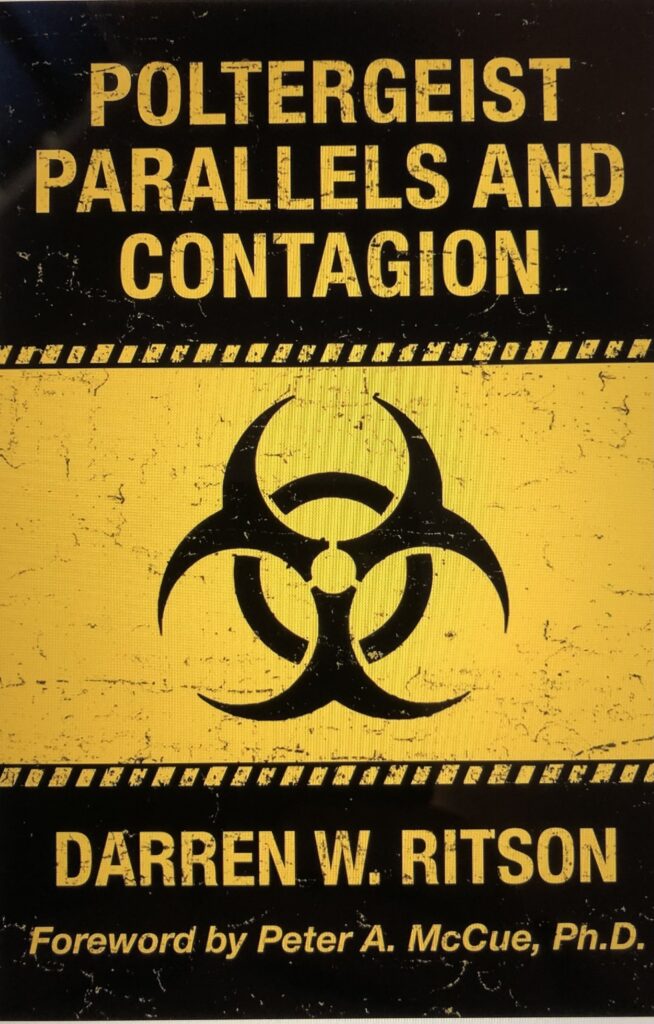
White Crow Books, 2021I; ISBN: 978-1-78677-177-3. Paperback: xxx + 246 pp.
A central thesis of this thoughtful and interesting book is that the poltergeist phenomenon is, as the title implies, contagious. Thus, having established itself at ‘ground zero’ – with what the author terms a ‘primary infestation’ – the poltergeist, essentially, ‘spreads’: through ‘stages’ of contagion in which family, friends, neighbours – even investigators – can become ‘infected’, albeit with a condition of ever-decreasing severity as the ‘malady’ atrophies with distance from the primary ‘infection site.’ I’m aware that there are a lot of inverted commas here and this is inevitable, somewhat, given that in using the viral metaphor the author is both drawing on a currently-resonant image whilst tacitly admitting that the mechanisms underlying poltergeist ‘transmission’ are not fully understood. Nonetheless, the hypothesis is an intriguing one, and one which is backed up with ample case material: both contemporary and historical.
Actually, the notion of an ‘author’ in the singular is not quite correct, here, for Poltergeist Parallels and Contagion is actually a revised edition of an earlier work co-authored by both Darren W. Ritson and Michael J. Hallowell, with the latter having apparently requested that his name be removed from this new edition ‘for personal reasons.’ This being acknowledged, the study is firmly that of two researchers: a fact amply borne out by ongoing evidence of Hallowell’s involvement at several key junctures.
Along the way, the study poses many interesting questions as it goes in search of answers. Why, for example, do so many poltergeist infestations display common characteristics? Could it be that poltergeists in the plural is actually ‘poltergeist’ in the singular: with one ‘entity’ – a sort of ‘arch-poltergeist’ – being responsible for each separate manifestation? I found this highly intriguing. After all, as Ritson avers, Biblical and other sources suggest that the notion of demons as numerically-distinct entities is a complex and contested one. And how else to explain the fact that so many poltergeist events resemble so many others, widely-separated in space and time? Indeed, one of the key strengths of this book is its wide-ranging scope, resulting in an immensely readable study in which no stone – thrown or otherwise – is left unturned.
Overall, I liked the way in which the principal investigators at the heart of this study were prepared to consider and reconsider their earlier positions, evaluating various theories in pursuit of an explanation of what the poltergeist, essentially, is, and not being afraid to leave open questions open. Whether or not such phenomena reveal the existence of a force or an entity goes to the heart of much of the debate surrounding these troublesome infestations, and this book covers all aspects of this key area lucidly and in detail. One final point is of note, however. The book makes reference, throughout, to Ritson and Hallowell’s previous study The South Shields Poltergeist. Whilst Poltergeist Parallels and Contagion works as a stand-alone study in its own right, my own reading of it would have been considerably enhanced if I had read the prior work first. This might be worth bearing in mind for those considering embarking on the latest tome. I would add, in passing, that Hallowell and Ritson’s study of the Willington Mill poltergeist, The Haunting of Willington Mill, remains one of the most compelling studies of a poltergeist infestation – including contagion ‘elements’ – that I have ever read.
This review first appeared in The Christian Parapsychologist, New Series, Vol 2, No 8, March 2023